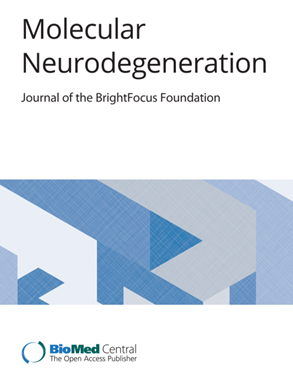Repetitive transcranial magnetic stimulation alleviates motor impairment in Parkinson’s disease: association with peripheral inflammatory regulatory T-cells and SYT6
IF 14.9
1区 医学
Q1 NEUROSCIENCES
引用次数: 0
Abstract
Repetitive transcranial magnetic stimulation (rTMS) has been used to treat various neurological disorders. However, the molecular mechanism underlying the therapeutic effect of rTMS on Parkinson’s disease (PD) has not been fully elucidated. Neuroinflammation like regulatory T-cells (Tregs) appears to be a key modulator of disease progression in PD. If rTMS affects the peripheral Tregs in PD remains unknown. Here, we conducted a prospective clinical study (Chinese ClinicalTrials. gov: ChiCTR 2100051140) involving 54 PD patients who received 10-day rTMS (10 Hz) stimulation on the primary motor cortex (M1) region or sham treatment. Clinical and function assessment as well as flow cytology study were undertaken in 54 PD patients who were consecutively recruited from the department of neurology at Zhujiang hospital between September 2021 and January 2022. Subsequently, we implemented flow cytometry analysis to examine the Tregs population in spleen of MPTP-induced PD mice that received rTMS or sham treatment, along with quantitative proteomic approach reveal novel molecular targets for Parkinson's disease, and finally, the RNA interference method verifies the role of these new molecular targets in the treatment of PD. We demonstrated that a 10-day rTMS treatment on the M1 motor cortex significantly improved motor dysfunction in PD patients. The beneficial effects persisted for up to 40 days, and were associated with an increase in peripheral Tregs. There was a positive correlation between Tregs and motor improvements in PD cases. Similarly, a 10-day rTMS treatment on the brains of MPTP-induced PD mice significantly ameliorated motor symptoms. rTMS reversed the downregulation of circulating Tregs and tyrosine hydroxylase neurons in these mice. It also increased anti-inflammatory mediators, deactivated microglia, and decreased inflammatory cytokines. These effects were blocked by administration of a Treg inhibitor anti-CD25 antibody in MPTP-induced PD mice. Quantitative proteomic analysis identified TLR4, TH, Slc6a3 and especially Syt6 as the hub node proteins related to Tregs and rTMS therapy. Lastly, we validated the role of Treg and rTMS-related protein syt6 in MPTP mice using the virus interference method. Our clinical and experimental studies suggest that rTMS improves motor function by modulating the function of Tregs and suppressing toxic neuroinflammation. Hub node proteins (especially Syt6) may be potential therapeutic targets. Chinese ClinicalTrials, ChiCTR2100051140. Registered 15 December 2021, https://www.chictr.org.cn/bin/project/edit?pid=133691 rTMS is a safe and non-invasive method for Parkinson's disease. In this study, we showed the proportion of CD4+CD25+CD127- regulatory T-cells (Tregs) in the peripheral blood was significantly increased after rTMS treatment. Similar effects of rTMS treatment were verified in MPTP-induced PD mice. Proteomic analysis and RNA interference analyses identified TLR4, TH, Slc6a3 and especially Syt6 as hub node proteins that can be modulated by rTMS therapy in PD.重复经颅磁刺激可减轻帕金森病的运动障碍:与外周炎性调节性 T 细胞和 SYT6 有关
重复经颅磁刺激(rTMS)已被用于治疗各种神经系统疾病。然而,经颅磁刺激治疗帕金森病(PD)的分子机制尚未完全阐明。调节性 T 细胞(Tregs)等神经炎症似乎是帕金森病疾病进展的一个关键调节因子。经颅磁刺激是否会影响帕金森病的外周Tregs仍是未知数。在此,我们进行了一项前瞻性临床研究(中国临床试验网:ChiCTR 2100051140),54名PD患者接受了为期10天的经颅磁刺激(10赫兹)或假治疗。我们对2021年9月至2022年1月期间从珠江医院神经内科连续招募的54名PD患者进行了临床和功能评估以及流式细胞学研究。随后,我们通过流式细胞术分析了接受经颅磁刺激或假治疗的MPTP诱导的帕金森病小鼠脾脏中的Tregs群体,并通过定量蛋白质组学方法揭示了帕金森病的新分子靶点,最后通过RNA干扰方法验证了这些新分子靶点在帕金森病治疗中的作用。我们证实,对 M1 运动皮层进行为期 10 天的经颅磁刺激治疗能显著改善帕金森病患者的运动功能障碍。这种益处可持续40天,并且与外周Tregs的增加有关。Tregs与运动功能改善之间存在正相关。同样,对多巴酚丁胺诱导的帕金森病小鼠大脑进行为期10天的经颅磁刺激治疗后,运动症状明显改善。经颅磁刺激还能增加抗炎介质、使小胶质细胞失活并减少炎性细胞因子。在 MPTP 诱导的帕金森病小鼠体内施用 Treg 抑制剂抗 CD25 抗体可阻断这些效应。定量蛋白质组分析发现,TLR4、TH、Slc6a3,尤其是 Syt6 是与 Tregs 和 rTMS 治疗相关的中枢节点蛋白。最后,我们利用病毒干扰法验证了 Treg 和 rTMS 相关蛋白 syt6 在 MPTP 小鼠中的作用。我们的临床和实验研究表明,经颅磁刺激通过调节Tregs的功能和抑制毒性神经炎症来改善运动功能。中枢节点蛋白(尤其是Syt6)可能是潜在的治疗靶点。中国临床试验网,ChiCTR2100051140。注册日期为2021年12月15日,https://www.chictr.org.cn/bin/project/edit?pid=133691 经颅磁刺激是治疗帕金森病的一种安全无创的方法。本研究显示,经颅磁刺激治疗后,外周血中CD4+CD25+CD127-调节性T细胞(Tregs)的比例显著增加。经颅磁刺激治疗在MPTP诱导的帕金森病小鼠中也验证了类似的效果。蛋白质组分析和RNA干扰分析发现,TLR4、TH、Slc6a3,尤其是Syt6是经颅磁刺激治疗可调节帕金森病的中枢节点蛋白。
本文章由计算机程序翻译,如有差异,请以英文原文为准。
求助全文
约1分钟内获得全文
求助全文
来源期刊

Molecular Neurodegeneration
医学-神经科学
CiteScore
23.00
自引率
4.60%
发文量
78
审稿时长
6-12 weeks
期刊介绍:
Molecular Neurodegeneration, an open-access, peer-reviewed journal, comprehensively covers neurodegeneration research at the molecular and cellular levels.
Neurodegenerative diseases, such as Alzheimer's, Parkinson's, Huntington's, and prion diseases, fall under its purview. These disorders, often linked to advanced aging and characterized by varying degrees of dementia, pose a significant public health concern with the growing aging population. Recent strides in understanding the molecular and cellular mechanisms of these neurodegenerative disorders offer valuable insights into their pathogenesis.
 求助内容:
求助内容: 应助结果提醒方式:
应助结果提醒方式:


